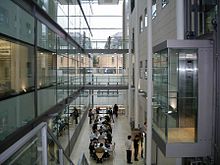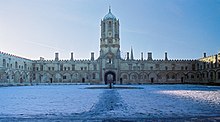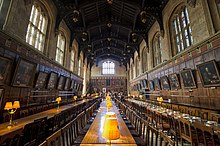The university is made up of a variety of institutions, including 38 constituent colleges and a full range of academic departments which are organised into four divisions.[10] All the colleges are self-governing institutions as part of the university, each controlling its own membership and with its own internal structure and activities.[11] Being a city university, it does not have a main campus; instead, all the buildings and facilities are scattered throughout the city centre. Most undergraduate teaching at Oxford is organised around weekly tutorials at the self-governing colleges and halls, supported by classes, lectures and laboratory work provided by university faculties and departments.
Oxford is the home of several notable scholarships, including the Clarendon Scholarship which was launched in 2001[12] and the Rhodes Scholarship which has brought graduate students to study at the university for more than a century.[13] The university operates the largest university press in the world[14] and the largest academic library system in the United Kingdom.[15] Oxford has educated many notable alumni, including 27 Nobel laureates, 26 British prime ministers (most recently David Cameron, the incumbent) and many foreign heads of state.[16]
Contents
[hide]History[edit]
See also: Timeline of Oxford
Founding[edit]
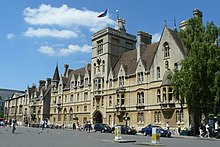
Balliol College – one of the university's oldest constituent colleges
After disputes between students and Oxford townsfolk in 1209, some academics fled from the violence to Cambridge, later forming the University of Cambridge.[9][19]
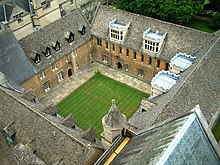
Aerial view of Merton College's Mob Quad, the oldest quadrangle of the university, constructed in the years from 1288 to 1378
In 1333–34, an attempt by some dissatisfied Oxford scholars to found a new university at Stamford, Lincolnshire was blocked by the universities of Oxford and Cambridge petitioning King Edward III.[26] Thereafter, until the 1820s, no new universities were allowed to be founded in England, even in London; thus, Oxford and Cambridge had a duopoly, which was unusual in western European countries.[27][28]
Renaissance period[edit]
The new learning of the Renaissance greatly influenced Oxford from the late 15th century onwards. Among university scholars of the period were William Grocyn, who contributed to the revival of Greek language studies, and John Colet, the noted biblical scholar.
With the Reformation and the breaking of ties with the Roman Catholic Church, recusant scholars from Oxford fled to continental Europe, settling especially at the University of Douai.[29] The method of teaching at Oxford was transformed from the medieval scholastic method to Renaissance education, although institutions associated with the university suffered losses of land and revenues. As a centre of learning and scholarship, Oxford's reputation declined in the Age of Enlightenment; enrolments fell and teaching was neglected.
In 1636, Chancellor William Laud, Archbishop of Canterbury, codified the university's statutes. These, to a large extent, remained its governing regulations until the mid-19th century. Laud was also responsible for the granting of a charter securing privileges for the University Press, and he made significant contributions to the Bodleian Library, the main library of the university. From the inception of the Church of England until 1866, membership of the church was a requirement to receive the B.A. degree from Oxford, and "dissenters" were only permitted to receive the M.A. in 1871.[30]
The university was a centre of the Royalist party during the English Civil War (1642–1649), while the town favoured the opposing Parliamentarian cause.[31] From the mid-18th century onwards, however, the University of Oxford took little part in political conflicts.
Wadham College, founded in 1610, was the undergraduate college of Sir Christopher Wren. Wren was part of a brilliant group of experimental scientists at Oxford in the 1650s, the Oxford Philosophical Club, which included Robert Boyle and Robert Hooke. This group held regular meetings at Wadham under the guidance of the College Warden, John Wilkins, and the group formed the nucleus which went on to found the Royal Society.
Modern period[edit]
The mid-19th century saw the impact of the Oxford Movement (1833–1845), led among others by the future Cardinal Newman. The influence of the reformed model of German university reached Oxford via key scholars such as Edward Bouverie Pusey, Benjamin Jowett and Max Müller.The system of separate honour schools for different subjects began in 1802, with Mathematics and Literae Humaniores.[32] Schools for Natural Sciences and Law, and Modern History were added in 1853.[32] By 1872, the latter was split into Jurisprudence and Modern History. Theology became the sixth honour school.[33] In addition to these B.A. Honours degrees, the postgraduate Bachelor of Civil Law (B.C.L.) was, and still is, offered.[34]

Brasenose Lane in the city centre, a street onto which three colleges back – Brasenose, Lincoln and Exeter.
The University of Oxford began to award doctorates in the first third of the 20th century. The first Oxford DPhil in mathematics was awarded in 1921.[35]
At the start of 1914 the university housed approximately three thousand undergraduates and about 100 postgraduate students. The First World War saw many undergraduates and fellows join the armed forces. By 1918 virtually all fellows were in uniform and the student population in residence was reduced to 12 per cent.[36] The University Roll of Service records that, in total, 14,792 members of the university served in the war, with 2,716 (18.36 per cent) killed.[37] During the war years the deserted university buildings became hospitals, cadet schools and military training camps.[36]
The mid-20th century saw many distinguished continental scholars, displaced by Nazism and communism, relocating to Oxford.
The list of distinguished scholars at the University of Oxford is long and includes many who have made major contributions to British politics, the sciences, medicine, and literature. More than 50 Nobel laureates and more than 50 world leaders have been affiliated with the University of Oxford.[16]
Women's education[edit]
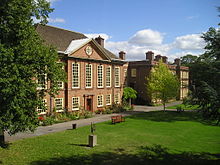
Somerville College was founded as one of Oxford's first women's colleges in 1879. It is now fully co-educational.
In 1974, Brasenose, Jesus, Wadham, Hertford and St Catherine's became the first previously all-male colleges to admit women.[46][47]
In 2008, the last single-sex college, St Hilda's, admitted its first men, so that all colleges are now co-residential. By 1988, 40% of undergraduates at Oxford were female;[48] the ratio was about 46%:54% in men's favour for the 2012 undergraduate admission.[49]
The detective novel Gaudy Night by Dorothy L. Sayers, herself one of the first women to gain an academic degree from Oxford, is largely set in a (fictional) women's college at Oxford, and the issue of women's education is central to its plot.
Buildings and sites[edit]
Main sites[edit]

The Sheldonian Theatre, built by Sir Christopher Wren between 1664 and 1668, hosts the university's Congregation, as well as concerts and degree ceremonies.
Iconic university buildings include the Radcliffe Camera, the Sheldonian Theatre used for music concerts, lectures, and university ceremonies, and the Examination Schools, where examinations and some lectures take place. The University Church of St Mary the Virgin was used for university ceremonies before the construction of the Sheldonian. Christ Church Cathedral uniquely serves as both a college chapel and as a cathedral.
In 2012–13, the university built the controversial one-hectare (400m × 25m) Castle Mill development of 4–5-storey blocks of student flats overlooking Cripley Meadow and the historic Port Meadow, blocking views of the spires in the city centre.[50] The development has been likened to building a "skyscraper beside Stonehenge".[51]
Parks[edit]

Autumn in the Botanic Garden
The Botanic Garden on the High Street is the oldest botanic garden in the UK. It contains over 8,000 different plant species on 1.8 ha (4 1⁄2 acres). It is one of the most diverse yet compact major collections of plants in the world and includes representatives of over 90% of the higher plant families. The Harcourt Arboretum is a 130-acre (53 ha) site six miles (10 km) south of the city that includes native woodland and 67 acres (27 hectares) of meadow. The 1,000-acre (4.0 km2) Wytham Woods are owned by the university and used for research in zoology and climate change.
There are also various collegiate-owned open spaces open to the public, including Bagley Wood and most notably Christ Church Meadow.[52]
Organisation[edit]
As a collegiate university, Oxford's structure can be confusing to those unfamiliar with it. The university is a federation, comprising over forty self-governing colleges and halls, along with a central administration headed by the Vice-Chancellor.Academic departments are located centrally within the structure of the federation; they are not affiliated with any particular college. Departments provide facilities for teaching and research, determine the syllabi and guidelines for the teaching of students, perform research, and deliver lectures and seminars.
Colleges arrange the tutorial teaching for their undergraduates, and the members of an academic department are spread around many colleges. Though certain colleges do have subject alignments (e.g., Nuffield College as a centre for the social sciences), these are exceptions, and most colleges will have a broad mix of academics and students from a diverse range of subjects. Facilities such as libraries are provided on all these levels: by the central university (the Bodleian), by the departments (individual departmental libraries, such as the English Faculty Library), and by colleges (each of which maintains a multi-discipline library for the use of its members).
Central governance[edit]
The university's formal head is the Chancellor, currently Lord Patten of Barnes, though as at most British universities, the Chancellor is a titular figure, and is not involved with the day-to-day running of the university. The Chancellor is elected by the members of Convocation, a body comprising all graduates of the university, and holds office until death.[53]
Wellington Square, the name of which has become synonymous with the university's central administration.
Two university proctors, elected annually on a rotating basis from two of the colleges, are the internal ombudsmen who make sure that the university and its members adhere to its statutes. This role incorporates student welfare and discipline, as well as oversight of the university's proceedings. The university's professors are collectively referred to as the "Statutory Professors of the University of Oxford". They are particularly influential in the running of the university's graduate programmes. Examples of statutory professors are the Chichele Professorships and the Drummond Professor of Political Economy. The various academic faculties, departments, and institutes are organised into four divisions, each with its own head and elected board. They are the Humanities division; the Social Sciences Division; the Mathematical, Physical and Life Sciences Division; and the Medical Sciences Division.
The University of Oxford is a "public university" in the sense that it receives some public money from the government, but it is a "private university" in the sense that it is entirely self-governing and, in theory, could choose to become entirely private by rejecting public funds.[54]
Colleges[edit]
Main article: Colleges of the University of Oxford

Chapel of Keble College, one of the constituent colleges of the University of Oxford
The colleges are:
 All Souls
All Souls Balliol
Balliol Brasenose
Brasenose Christ Church
Christ Church Corpus Christi
Corpus Christi Exeter
Exeter Green Templeton
Green Templeton Harris Manchester
Harris Manchester Hertford
Hertford Jesus
Jesus Keble
Keble Kellogg
Kellogg Lady Margaret Hall
Lady Margaret Hall Linacre
Linacre Lincoln
Lincoln Magdalen
Magdalen Mansfield
Mansfield Merton
Merton New College
New College Nuffield
Nuffield Oriel
Oriel Pembroke
Pembroke Queen's
Queen's Somerville
Somerville St Anne's
St Anne's St Antony's
St Antony's St Catherine's
St Catherine's St Cross
St Cross St Edmund Hall
St Edmund Hall St Hilda's
St Hilda's St Hugh's
St Hugh's St John's
St John's St Peter's
St Peter's Trinity
Trinity University
University Wadham
Wadham Wolfson
Wolfson Worcester
Worcester
The PPHs and colleges join together as the Conference of Colleges, which represents the common concerns of the several colleges of the University, and to discuss policy and to deal with the central university administration.[55][56] The Conference of Colleges was established as a recommendation of the Franks Commission in 1965.[57]
Teaching members of the colleges (i.e. fellows and tutors) are collectively and familiarly known as dons, although the term is rarely used by the university itself. In addition to residential and dining facilities, the colleges provide social, cultural, and recreational activities for their members. Colleges have responsibility for admitting undergraduates and organising their tuition; for graduates, this responsibility falls upon the departments. There is no common title for the heads of colleges: the titles used include Warden, Provost, Principal, President, Rector, Master and Dean.
Finances[edit]
In 2014/15, the university had an income of £1,429m; key sources were research grants (£522.9m) and academic fees (£258.3m).[58] The colleges had a total income of £415m,[59]
While the university has the larger annual income and operating budget, the colleges have a larger aggregate endowment: over £3.5bn compared to the University's £834m.[60] The Central University's endowment, along with some of the colleges', is managed by the university's wholly owned endowment management office, Oxford University Endowment Management, formed in 2007.[61] The university has substantial investments in fossil fuel companies, and in 2014 began consultations on whether it should follow some US universities which have committed to sell off their fossil fuel investments.[62]
The university launched a fundraising campaign in May 2008, called "Oxford Thinking – The Campaign for the University of Oxford".[63] This is looking to support three areas: academic posts and programmes, student support, and buildings and infrastructure;[64] having passed its original target of £1.25 billion in March 2012, the target has now been raised to £3 billion.[58]
Affiliations[edit]
Oxford is a member of the Russell Group of research-led British universities, the G5, the League of European Research Universities, and the International Alliance of Research Universities. It is also a core member of the Europaeum and forms part of the "golden triangle" of highly research intensive and elite English universities.[65]Academic profile[edit]
Admission[edit]
In common with most British universities, prospective students apply through the UCAS application system, but prospective applicants for the University of Oxford, along with those for medicine, dentistry, and University of Cambridge applicants, must observe an earlier deadline of 15 October.[66]To allow a more personalised judgement of students, who might otherwise apply for both, undergraduate applicants are not permitted to apply to both Oxford and Cambridge in the same year. The only exceptions are applicants for organ scholarships[67] and those applying to read for a second undergraduate degree.[68]
Most applicants choose to apply to one of the individual colleges, which work with each other to ensure that the best students gain a place somewhere at the University regardless of their college preferences.[69] Shortlisting is based on achieved and predicted exam results, school references, and, in some subjects, written admission tests or candidate-submitted written work. Approximately 60% of applicants are shortlisted, although this varies by subject. If a large number of shortlisted applicants for a subject choose one college, then students who named that college may be reallocated randomly to under-subscribed colleges for the subject. The colleges then invite shortlisted candidates for interview, where they are provided with food and accommodation for around three days in December. Most applicants will be individually interviewed by academics at more than one college. Students from outside Europe can be interviewed remotely, for example, over the Internet.
Offers are sent out in early January, with each offer usually being from a specific college. One in four successful candidates receives an offer from a college that they did not apply to. Some courses may make "open offers" to some candidates, who are not assigned to a particular college until A Level results day in August.[70][71]
Teaching and degrees[edit]
Main articles: Degrees of the University of Oxford, List of professorships at the University of Oxford and Undergraduate education at University of Oxford
Undergraduate teaching is centred on the tutorial, where 1–4 students spend an hour with an academic discussing their week's work, usually an essay (humanities, most social sciences, some mathematical, physical, and life sciences) or problem sheet (most mathematical, physical, and life sciences, and some social sciences). The university itself is responsible for conducting examinations and conferring degrees. Undergraduate teaching takes place during three eight-week academic terms: Michaelmas, Hilary and Trinity.[72] (These are officially known as 'Full Term': 'Term' is a lengthier period with little practical significance.) Internally, the weeks in a term begin on Sundays, and are referred to numerically, with the initial week known as "first week", the last as "eighth week" and with the numbering extended to refer to weeks before and after term (for example "-1st week" and "0th week" precede term). Undergraduates must be in residence from Thursday of 0th week. These teaching terms are shorter than those of most other British universities,[73] and their total duration amounts to less than half the year. However, undergraduates are also expected to do some academic work during the three holidays (known as the Christmas, Easter, and Long Vacations).Research degrees at the master's and doctoral level are conferred in all subjects studied at graduate level at the university.
Scholarships and financial support[edit]
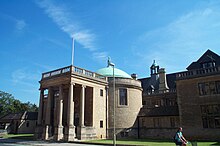
Rhodes House – home to the awarding body for the Rhodes Scholarships, often considered to be the world's most prestigious scholarship.
Students successful in early examinations are rewarded by their colleges with scholarships and exhibitions, normally the result of a long-standing endowment, although since the introduction of tuition fees the amounts of money available are purely nominal. Scholars, and exhibitioners in some colleges, are entitled to wear a more voluminous undergraduate gown; "commoners" (originally those who had to pay for their "commons", or food and lodging) are restricted to a short, sleeveless garment. The term "scholar" in relation to Oxford therefore had a specific meaning as well as the more general meaning of someone of outstanding academic ability. In previous times, there were "noblemen commoners" and "gentlemen commoners", but these ranks were abolished in the 19th century. "Closed" scholarships, available only to candidates who fitted specific conditions such as coming from specific schools, now exist only in name.
Libraries[edit]
The university maintains the largest university library system in the UK,[15] and, with over 11 million volumes housed on 120 miles (190 km) of shelving, the Bodleian group is the second-largest library in the UK, after the British Library. The Bodleian is a legal deposit library, which means that it is entitled to request a free copy of every book published in the UK. As such, its collection is growing at a rate of over three miles (five kilometres) of shelving every year.[79]The buildings referred to as the University's main research library, The Bodleian, consist of the original Bodleian Library in the Old Schools Quadrangle, founded by Sir Thomas Bodley in 1598 and opened in 1602,[80] the Radcliffe Camera, the Clarendon Building, and the New Bodleian Building. A tunnel underneath Broad Street connects these buildings, with the Gladstone Link connecting the Old Bodleian and Radcliffe Camera opening to readers in 2011.

The Clarendon Building is home to many senior Bodleian Library staff and previously housed the university's own central administration.
A new book depository opened in South Marston, Swindon in October 2010,[85] and current building projects include the remodelling of the New Bodleian building, which will be renamed the Weston Library when it reopens in 2014–15.[86] The renovation is designed to better showcase the library's various treasures (which include a Shakespeare First Folio and a Gutenberg Bible) as well as temporary exhibitions.
The Bodleian engaged in a mass-digitisation project with Google in 2004.[87][88]
Museums[edit]
Oxford maintains a number of museums and galleries, open for free to the public. The Ashmolean Museum, founded in 1683, is the oldest museum in the UK, and the oldest university museum in the world.[89] It holds significant collections of art and archaeology, including works by Michelangelo, Leonardo da Vinci, Turner, and Picasso, as well as treasures such as the Scorpion Macehead, the Parian Marble and the Alfred Jewel. It also contains "The Messiah", a pristine Stradivarius violin, regarded by some as one of the finest examples in existence.The University Museum of Natural History holds the University's zoological, entomological and geological specimens. It is housed in a large neo-Gothic building on Parks Road, in the University's Science Area.[90][91] Among its collection are the skeletons of a Tyrannosaurus rex and Triceratops, and the most complete remains of a dodo found anywhere in the world. It also hosts the Simonyi Professorship of the Public Understanding of Science, currently held by Marcus du Sautoy.

The interior of the Pitt Rivers Museum
The Museum of the History of Science is housed on Broad St in the world's oldest-surviving purpose-built museum building.[92] It contains 15,000 artefacts, from antiquity to the 20th century, representing almost all aspects of the history of science. In the Faculty of Music on St Aldate's is the Bate Collection of Musical Instruments, a collection mostly of instruments from Western classical music, from the medieval period onwards. Christ Church Picture Gallery holds a collection of over 200 old master paintings.
Publishing[edit]
Main article: Oxford University Press
The Oxford University Press is the world's second oldest and currently the largest university press by the number of publications.[14] More than 6,000 new books are published annually,[93] including many reference, professional, and academic works (such as the Oxford English Dictionary, the Concise Oxford English Dictionary, the Oxford World's Classics, the Oxford Dictionary of National Biography, and the Concise Dictionary of National Biography).Rankings and reputation[edit]
| ARWU[94] (2015, national) | 2 | |
|---|---|---|
| ARWU[95] (2015, world) | 10 | |
| QS[96] (2015/16, national) | 2 | |
| QS[97] (2015/16, world) | 6 | |
| THE[98] (2015/16, national) | 1 | |
| THE[98] (2015/16, world) | 2 | |
| THE Reputation[99] (2015, national) | 2 | |
| THE Reputation[99] (2015, world) | 3 | |
| Complete[100] (2016, national) | 2 | |
| The Guardian[101] (2016, national) | 2 | |
| Times/Sunday Times[102] (2016, national) | 2 | |
Oxford is ranked 5th best university worldwide and 1st in the United Kingdom for forming CEOs according to the Professional Ranking World Universities.[107] It is ranked first in the UK for the quality of its graduates as chosen by the recruiters of the UK's major companies.[108]
In the 2016 Complete University Guide, 34 out of the 35 subjects offered by Oxford rank within the top 10 nationally meaning Oxford was one of only four multi-faculty universities (along with Cambridge, Durham and St Andrews) in the UK to have over 90% of their subjects in the top 10.[109] Art & Design, East & South Asian Studies, Medicine, Music, Philosophy and Politics were ranked first in the UK by the guide.[110]
Student life[edit]
Traditions[edit]
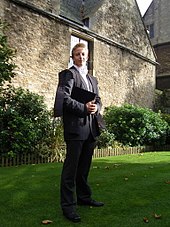
An undergraduate student at the University of Oxford in subfusc for matriculation
Other traditions and customs vary by college. For example, some colleges have formal hall six times a week, but in others this only happens occasionally. At most colleges these formal meals require gowns to be worn, and a Latin grace is said.
Balls are major events held by colleges; the largest, held triennially in 9th week of Trinity Term, are called Commemoration balls; the dress code is usually white tie. Many other colleges hold smaller events during the year that they call summer balls or parties. These are usually held on an annual or irregular basis, and are usually black tie.
Punting is a common summer leisure activity.
There are several more or less quirky traditions peculiar to individual colleges, for example the All Souls mallard song.
Clubs and societies[edit]
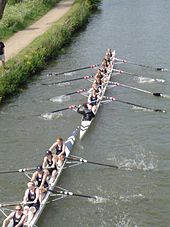
Rowing at Summer Eights, an annual intercollegiate bumps race
There are two weekly student newspapers: the independent Cherwell and OUSU's The Oxford Student. Other publications include the Isis magazine, The Owl Journal, the satirical Oxymoron, and the graduate Oxonian Review. The student radio station is Oxide Radio. Most colleges have chapel choirs. Music, drama, and other arts societies exist both at collegiate level and as university-wide groups. Unlike most other collegiate societies, musical ensembles actively encourage players from other colleges.

The Oxford Union's debating chamber
The Oxford Union (not to be confused with the Oxford University Student Union) hosts weekly debates and high profile speakers. There have historically been elite invite-only societies such as the Bullingdon Club.
Sports teams, but also other societies and groups organised especially for the purpose, often take part in crewdates. These evenings involve 'crews' (often one of each gender, hence the name) going for a meal and consuming much alcohol, before heading to a nightclub.[115]
OUSU and Common Rooms[edit]
The Oxford University Student Union, better known by its acronym OUSU, exists to represent students in the University's decision-making, to act as the voice for students in the national higher education policy debate, and to provide direct services to the student body. Reflecting the collegiate nature of the University of Oxford itself, OUSU is both an association of Oxford's more than 21,000 individual students and a federation of the affiliated college common rooms, and other affiliated organisations that represent subsets of the undergraduate and graduate students. The OUSU Executive Committee includes six full-time salaried sabbatical officers, who generally serve in the year following completion of their Final Examinations.The importance of collegiate life is such that for many students their college JCR (Junior Common Room, for undergraduates) or MCR (Middle Common Room, for graduates) is seen as more important than OUSU. JCRs and MCRs each have a committee, with a president and other elected students representing their peers to college authorities. Additionally, they organise events and often have significant budgets to spend as they wish (money coming from their colleges and sometimes other sources such as student-run bars). (It is worth noting that JCR and MCR are terms that are used to refer to rooms for use by members, as well as the student bodies.) Not all colleges use this JCR/MCR structure, for example Wadham College's entire student population is represented by a combined Students' Union and purely graduate colleges have different arrangements.
Notable alumni[edit]
Main article: List of University of Oxford people
Throughout its history, a sizeable number of Oxford alumni, known as Oxonians, have become notable in many varied fields, both academic and otherwise, ranging from T. E. Lawrence, British Army officer known better as Lawrence of Arabia[116] to the explorer, courtier, and man of letters, Sir Walter Raleigh, (who attended Oriel College but left without taking a degree);[117] and the Australian media mogul, Rupert Murdoch.[118] Moreover, 58 Nobel prize-winners have studied or taught at Oxford, with prizes won in all six categories.[16] More information on famous senior and junior members of the University can be found in the individual college articles. An individual may be associated with two or more colleges, as an undergraduate, postgraduate, and/or member of staff.Politics[edit]
Political leaders who attended Oxford University
Over 100 Oxford alumni were elected to the House of Commons in 2010.[120] This includes former Leader of the Opposition, Ed Miliband, and numerous members of the cabinet and shadow cabinet. Additionally, over 140 Oxonians sit in the House of Lords.[16]
At least 30 other international leaders have been educated at Oxford[16] This number includes Harald V of Norway,[121] Abdullah II of Jordan,[16] five Prime Ministers of Australia (John Gorton, Malcolm Fraser, Bob Hawke, Tony Abbott, and Malcolm Turnbull)[122][123][124] two Prime Ministers of Canada (Lester B. Pearson and John Turner),[16][125] two Prime Ministers of India (Manmohan Singh and Indira Gandhi (although she did not finish her degree)),[16][126] five Prime Ministers of Pakistan (Liaquat Ali Khan, Huseyn Shaheed Suhrawardy, Sir Feroz Khan Noon, Zulfiqar Ali Bhutto, and Benazir Bhutto),[16] S. W. R. D. Bandaranaike (former Prime Minister of Ceylon), Norman Washington Manley of Jamaica,[127] Eric Williams (Prime Minister of Trinidad and Tobago), Álvaro Uribe (Colombia's former President), Abhisit Vejjajiva (former Prime Minister of Thailand) and Bill Clinton (the first President of the United States to have attended Oxford; he attended as a Rhodes Scholar).[16][128] Arthur Mutambara (Deputy Prime Minister of Zimbabwe), was a Rhodes Scholar in 1991. Festus Mogae (former president of Botswana) was a student at University College. The Burmese democracy activist and Nobel laureate, Aung San Suu Kyi, was a student of St. Hugh's College.[129]
Mathematics and sciences[edit]
Three Oxford mathematicians, Michael Atiyah, Daniel Quillen and Simon Donaldson, have won Fields Medals, often called the "Nobel Prize for mathematics". Andrew Wiles, who proved Fermat's Last Theorem, was educated at Oxford and is currently a Royal Society Research Professor at Oxford. Marcus du Sautoy and Roger Penrose are both currently mathematics professors. Stephen Wolfram, chief designer of Mathematica and Wolfram Alpha studied at the university, along with Tim Berners-Lee,[16] inventor of the World Wide Web,[130] Edgar F. Codd, inventor of the relational model of data,[131] and Tony Hoare, programming languages pioneer and inventor of Quicksort.
The University is associated with eleven winners of the Nobel Prize in Chemistry, five in physics and sixteen in medicine.[132]
Scientists who performed research in Oxford include chemist Dorothy Hodgkin who received her Nobel Prize for "determinations by X-ray techniques of the structures of important biochemical substances".[133] Both Richard Dawkins[134] and Frederick Soddy[135] studied at the university and returned for research purposes. Robert Hooke,[16] Edwin Hubble,[16] and Stephen Hawking[16] all studied in Oxford.
Robert Boyle, a founder of modern chemistry, never formally studied or held a post within the university, but resided within the city to be part of the scientific community and was awarded an honorary degree.[136] Notable scientists who spent brief periods at Oxford include Albert Einstein[137] developer of general theory of relativity and the concept of photons; and Erwin Schrödinger who formulated the Schrödinger equation and the Schrödinger's cat thought experiment.
Economists Adam Smith, Alfred Marshall, E. F. Schumacher, and Amartya Sen all spent time at Oxford.
Literature, music, and drama[edit]
The long list of writers associated with Oxford includes John Fowles, Theodor Geisel, Thomas Middleton, Samuel Johnson, Christopher Hitchens, Robert Graves, Evelyn Waugh,[138] Lewis Carroll,[139] Aldous Huxley,[140] Oscar Wilde,[141] C. S. Lewis,[142] J. R. R. Tolkien,[143] Graham Greene,[144] V.S.Naipaul, Philip Pullman,[16] Joseph Heller,[145] Vikram Seth,[16] the poets Percy Bysshe Shelley,[146] John Donne,[147] A. E. Housman,[148] W. H. Auden,[149] T. S. Eliot, Wendy Perriam and Philip Larkin,[150] and seven poets laureate: Thomas Warton,[151] Henry James Pye,[152] Robert Southey,[153] Robert Bridges,[154] Cecil Day-Lewis,[155] Sir John Betjeman,[156] and Andrew Motion.[157]
Composers Hubert Parry, George Butterworth, John Taverner, William Walton, James Whitbourn and Andrew Lloyd Webber have all been involved with the university.
Actors Hugh Grant,[158] Kate Beckinsale,[158] Dudley Moore,[159] Michael Palin,[16] Terry Jones,[160] Anna Popplewell, and Rowan Atkinson were undergraduates at the University, as were filmmakers Ken Loach[161] and Richard Curtis.[16]
Religion[edit]
Oxford has also produced at least 12 saints, and 20 Archbishops of Canterbury, the most recent Archbishop being Rowan Williams, who studied at Wadham College and was later a Canon Professor at Christ Church.[16][162] Religious reformer John Wycliffe was an Oxford scholar, for a time Master of Balliol College. John Colet, Christian humanist, Dean of St Paul's, and friend of Erasmus, studied at Magdalen College. The founder of Methodism, John Wesley, studied at Christ Church and was elected a fellow of Lincoln College.[163] The Oxford Movement(1833–1845) was closely associated with the Oriel Fellows John Henry Newman, Edward Bouverie Pusey and John Keble. Other religious figures were Mirza Nasir Ahmad, the third Caliph of the Ahmadiyya Muslim Community, Shoghi Effendi, one of the appointed leaders of the Baha'i faith and Joseph Cordeiro, the only Pakistani Catholic cardinal.[164]Philosophy[edit]
Oxford's philosophical tradition started in the medieval era, with Robert Grosseteste[165] and William of Ockham,[165] commonly known for Occam's razor, among those teaching at the university. Thomas Hobbes,[166][167] Jeremy Bentham and the empiricist John Locke received degrees from Oxford. Though the latter's main works were written after leaving Oxford, Locke was heavily influenced by his twelve years at the university.[165]
Philosophy was never absent from Oxford's preoccupations. Oxford philosophers of the 20th century include Gilbert Ryle,[165] author of the influential The Concept of Mind, who spent his entire philosophical career at the university and Derek Parfit, who specialises in personal identity and related matters. Other commonly read modern philosophers to have studied at the university include A. J. Ayer,[165] Paul Grice, Thomas Nagel, known for his essay "What Is it Like to Be a Bat?", Robert Nozick and John Rawls. John Searle, presenter of the Chinese room thought experiment, studied and began his academic career at the university.[168]
Sport[edit]
Some 50 Olympic medal-winners have academic connections with the university, including Sir Matthew Pinsent, quadruple gold-medallist rower.[16][169] Other sporting connections include Imran Khan.[16]Rowers from Oxford who have won gold at the Olympics or World Championships include Michael Blomquist, Ed Coode, Chris Davidge, Hugh Edwards, Jason Flickinger, Tim Foster, Christopher Liwski, Matthew Pinsent, Pete Reed, Jonny Searle, Andrew Triggs Hodge, Jake Wetzel, Michael Wherley, and Barney Williams. Many Oxford graduates have also risen to the highest echelon in cricket: Harry Altham, Bernard Bosanquet (inventor of the googly), Colin Cowdrey, Gerry Crutchley, Jamie Dalrymple, Martin Donnelly, R. E. Foster (the only man to captain England at both cricket and football), C. B. Fry, George Harris (also served in the House of Lords), Douglas Jardine, Malcolm Jardine, Imran Khan, Alan Melville, Iftikhar Ali Khan Pataudi, Mansoor Ali Khan Pataudi, M. J. K. Smith, and Pelham Warner.
Oxford students have also excelled in other sports. Such alumni include American football player Myron Rolle (NFL player); Olympic gold medalists in athletics David Hemery and Jack Lovelock; basketball players Bill Bradley (US Senator and NBA player) and Charles Thomas McMillen (US Congressman and NBA player); figure skater John Misha Petkevich (national champion); footballers John Bain, Charles Wreford-Brown, and Cuthbert Ottaway; modern pentathlete Steph Cook (Olympic gold medalist); rugby footballers Stuart Barnes, Simon Danielli, David Humphreys, David Edward Kirk, Anton Oliver, Ronald Poulton-Palmer, Joe Roff, and William Webb Ellis (allegedly the inventor of rugby football); runner Sir Roger Gilbert Bannister (who ran the first sub-four-minute mile), World Cup ski racer Ryan Max Riley (national champion); and tennis player Clarence Bruce.
Adventure and exploration[edit]
Three of the most well-known adventurers and explorers who attended Oxford are Walter Raleigh, one of the most notable figures of the Elizabethan era, T. E. Lawrence, whose life was the basis of the 1962 film Lawrence of Arabia, and Thomas Coryat. The latter, the author of "Coryat's Crudities hastily gobbled up in Five Months Travels in France, Italy, &c'" (1611) and court jester of Henry Frederick, Prince of Wales, is credited with introducing the table fork and umbrella to England and being the first Briton to do a Grand Tour of Europe.[170]
Other notable figures include Gertrude Bell, an explorer, archaeologist, mapper and spy, who, along with T. E. Lawrence, helped establish the Hashemite dynasties in what is today Jordan and Iraq and played a major role in establishing and administering the modern state of Iraq; Richard Francis Burton, who travelled in disguise to Mecca and journeyed with John Hanning Speke as the first European explorers to visit the Great Lakes of Africa in search of the source of the Nile; mountaineer Tom Bourdillon, member of the expedition to make the first ascent of Mount Everest; and Peter Fleming, adventurer and travel writer and elder brother of Ian Fleming, creator of James Bond.
Oxford in literature and other media[edit]
Main article: University of Oxford in popular culture
The University of Oxford is the setting for numerous works of fiction. Oxford was mentioned in fiction as early as 1400 when Chaucer in his Canterbury Tales referred to a "Clerk [student] of Oxenford". By 1989, 533 novels based in Oxford had been identified and the number continues to rise.[171] Famous literary works range from Brideshead Revisited by Evelyn Waugh, to the trilogy His Dark Materials by Philip Pullman, which features an alternate-reality version of the university.Other notable examples include:
- Gaudy Night, a Lord Peter Wimsey mystery by Dorothy L. Sayers (who was herself a graduate of Somerville College).
- The Inspector Morse series by Colin Dexter, and its spin off Lewis, are set in Oxford and frequently refer to the university (although most of the college names are fictional).
- Zuleika Dobson, by Max Beerbohm
- Brideshead Revisited (1981), based on Waugh's novel; a miniseries enormously popular in Britain and America, the film has sometimes been seen as drawing unwanted attention to Oxford's stereotypical reputation as a playground of the upper classes. It stars Jeremy Irons and most college shots are of Christ Church and Hertford.
- True Blue (1996), about the mutiny at the time of the Oxford-Cambridge Boat Race of 1987
- The History Boys (film) (2008) movie about a group of boys applying to do history at Oxford. Set in 1983 and based on the play by Alan Bennett.
- The Golden Compass (film) (2007)
- The Riot Club (2014)




